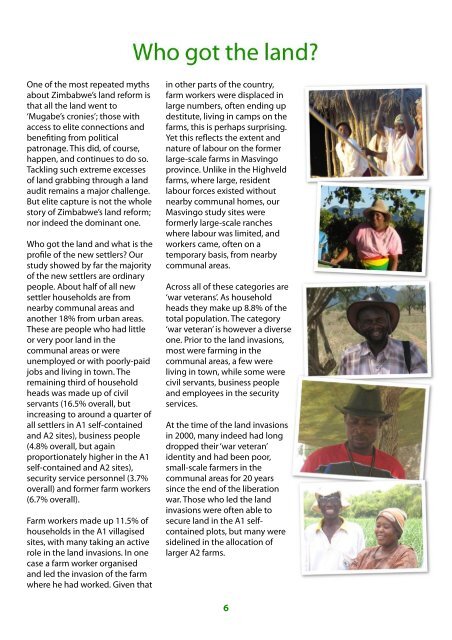Zimbabwe's Land Reform
Zimbabwe's Land Reform
Zimbabwe's Land Reform
You also want an ePaper? Increase the reach of your titles
YUMPU automatically turns print PDFs into web optimized ePapers that Google loves.
One of the most repeated myths<br />
about Zimbabwe’s land reform is<br />
that all the land went to<br />
‘Mugabe’s cronies’; those with<br />
access to elite connections and<br />
benefiting from political<br />
patronage. This did, of course,<br />
happen, and continues to do so.<br />
Tackling such extreme excesses<br />
of land grabbing through a land<br />
audit remains a major challenge.<br />
But elite capture is not the whole<br />
story of Zimbabwe’s land reform;<br />
nor indeed the dominant one.<br />
Who got the land and what is the<br />
profile of the new settlers? Our<br />
study showed by far the majority<br />
of the new settlers are ordinary<br />
people. About half of all new<br />
settler households are from<br />
nearby communal areas and<br />
another 18% from urban areas.<br />
These are people who had little<br />
or very poor land in the<br />
communal areas or were<br />
unemployed or with poorly-paid<br />
jobs and living in town. The<br />
remaining third of household<br />
heads was made up of civil<br />
servants (16.5% overall, but<br />
increasing to around a quarter of<br />
all settlers in A1 self-contained<br />
and A2 sites), business people<br />
(4.8% overall, but again<br />
proportionately higher in the A1<br />
self-contained and A2 sites),<br />
security service personnel (3.7%<br />
overall) and former farm workers<br />
(6.7% overall).<br />
Farm workers made up 11.5% of<br />
households in the A1 villagised<br />
sites, with many taking an active<br />
role in the land invasions. In one<br />
case a farm worker organised<br />
and led the invasion of the farm<br />
where he had worked. Given that<br />
in other parts of the country,<br />
farm workers were displaced in<br />
large numbers, often ending up<br />
destitute, living in camps on the<br />
farms, this is perhaps surprising.<br />
Yet this reflects the extent and<br />
nature of labour on the former<br />
large-scale farms in Masvingo<br />
province. Unlike in the Highveld<br />
farms, where large, resident<br />
labour forces existed without<br />
nearby communal homes, our<br />
Masvingo study sites were<br />
formerly large-scale ranches<br />
where labour was limited, and<br />
workers came, often on a<br />
temporary basis, from nearby<br />
communal areas.<br />
Across all of these categories are<br />
‘war veterans’. As household<br />
heads they make up 8.8% of the<br />
total population. The category<br />
‘war veteran’ is however a diverse<br />
one. Prior to the land invasions,<br />
most were farming in the<br />
communal areas, a few were<br />
living in town, while some were<br />
civil servants, business people<br />
and employees in the security<br />
services.<br />
At the time of the land invasions<br />
in 2000, many indeed had long<br />
dropped their ‘war veteran’<br />
identity and had been poor,<br />
small-scale farmers in the<br />
communal areas for 20 years<br />
since the end of the liberation<br />
war. Those who led the land<br />
invasions were often able to<br />
secure land in the A1 selfcontained<br />
plots, but many were<br />
sidelined in the allocation of<br />
larger A2 farms.<br />
6

















